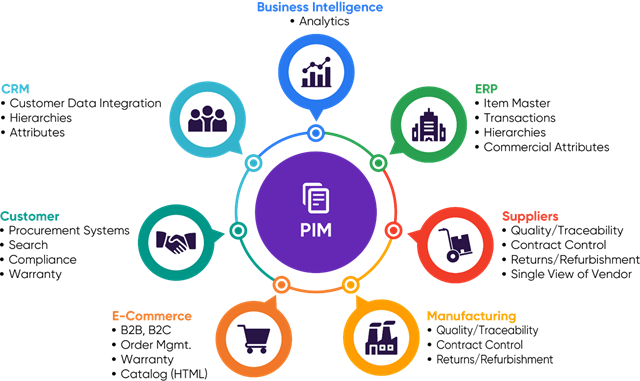Efficient management and rapid dissemination of product information is critical to e-commerce success. Product Information Management (PIM) systems make that happen.
PIMs are revolutionizing the way businesses handle intricate details about their products. They save time, enhance conversions and revenue, bolster SEO, and address scalability challenges. Whether you’re a small business with a growing product list or an enterprise managing an extensive catalog, understanding the potential of PIM systems can spur growth in the competitive landscape of e-commerce.
What Is a Product Information Management System?
PIM systems facilitate storage and management of intricate product information. They can compile all the information needed to market and sell your products on your various sales channels. PIMs help everyone on a team, from designers to product engineers, work together seamlessly to ensure that products are made, priced, and sold with smooth efficiency.
From a technical side, a PIM hosts all the product dimensions, shapes, colors, sizes, ingredients, SKU data, documentation, and any other specs. You can also compile all the imagery, videos, product descriptions, and other value statements about your products in one place.
PIM systems differ from CMS databases. PIMs host large amounts of information and understand relationships among data sets in ways that improve your understanding of customer needs. CMS databases are mainly for maintaining websites and general storage of website data.

Image Source: Pimcore
Benefits of Product Information Management
Save Time
A PIM system saves time in several ways, starting with the quality of data and consistency of data. No more multiple manual implementations across various sales platforms, no more duplicate information; the PIM centralizes price changes and product information updates for quick deployment across all channels.
PIM systems relieve bottlenecks and reduce time to market. Each of the teams that, together, shepherd a product to market have one place to approve and input updates. The information can then be pushed out quickly across all channels. The speed or delays of getting new products to market and selling off discounted products during busy seasons (think Black Friday) can make or break budgets. PIM systems alleviate the stress of information dissemination.
Boost Conversions and Revenue
Nothing is worse than finding misleading, old, or contradictory information/pricing about your products on various e-commerce channels. Your PIM – a single, central hub of all specs – gives your customers consistent, quality product information everywhere. That instills customer confidence in your business. And confidence drives higher conversion rates, fewer product returns, more revenue, and better ROI.
Achieve Rock Solid SEO
A PIM system keeps all the product data in one resource and updates it everywhere automatically. You’ll know that your metadata is accurate and that updates push out in timely fashion. The PIM also structures your data in ways that help search engines to crawl and index your e-commerce site efficiently and accurately. Effective indexing raises your search engine rankings.
PIM systems also present product data in a consistent and structured way. Google loves structured data, and you can connect your PIM system to Google Merchant Center to help get your products promoted in rich snippets on Google. (Get detailed SEO tips for e-commerce stores.)
Eliminate Scalability Issues
As you launch new product lines, marketing campaigns, and sales channels, your PIM system scales for increased data and distribution needs. Businesses also add CRM, MAP, and ERP systems, just to name a few. PIM systems integrate with these platforms to ensure continuity across all utilized resources.
Without a PIM, quick scaling can make it hard to understand how products relate to one another, in terms of cross-sales and inventory on hand. A PIM system addresses both concerns. It consolidates inventory information in one location, and the software clarifies relationships among products. Predictive information from the PIM helps with upselling and with related-product sales.
Is a PIM Right for Me?
Key considerations for determining if a PIM is right for your company are the number of products you offer and the size of your team. If you manage about 100 products and a small team, that probably doesn't justify a PIM. But it likely does justify research into one as part of a growth plan.
If you have a sales team, marketing team, product engineers, designers, and other executives involved in product launches and designs, a PIM is likely to be essential to e-commerce growth. When you get into hundreds of products, you should consider a PIM to help effectively manage and market them.
Price, as always, is a consideration. Most PIM systems have entry-level versions, with prices that can scale up quickly. Countless options, with robust features, are on the market at varying price points. Capterra offers a great comparison guide of top PIM platforms.
Whether you’re ready right now or a couple of years out, plan carefully and research thoroughly before committing resources to a large PIM system. The onboarding process and staff training take time.
Note that a PIM system is not a one-stop solution for every e-commerce challenge. You still must pay careful attention to your website and CRM platforms. A PIM is simply one tool to help scale and transform your e-commerce site.
Need assistance determining whether a PIM is right for you or integrating it into your website? Don't hesitate to reach out! Our e-commerce experts are ready to help.






